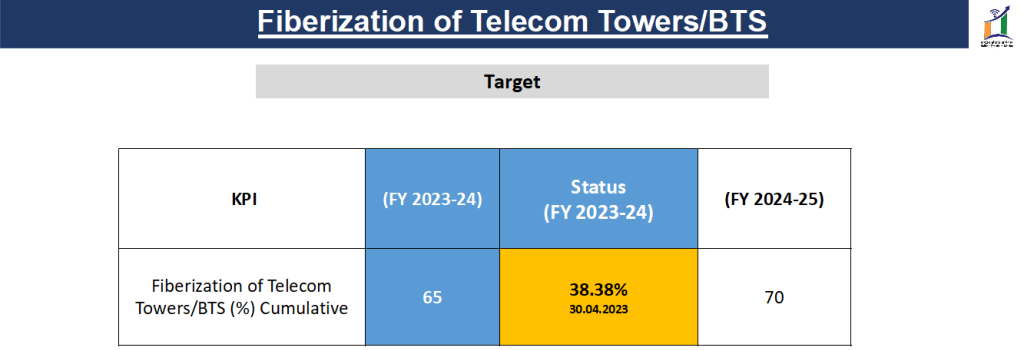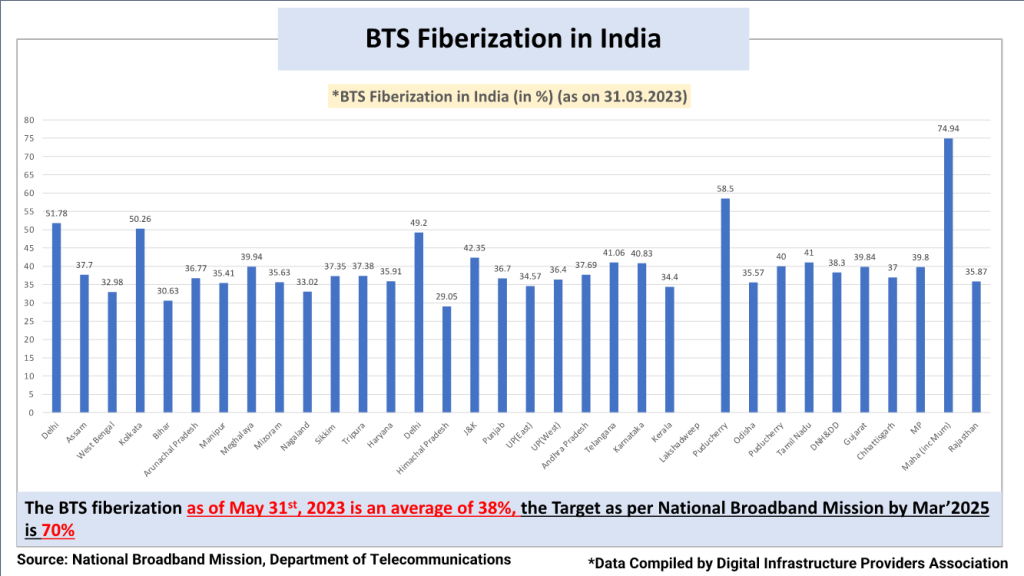5G Perspective
Telecom towers fiberization – The master key for faster 5G rollout

The Indian telecom sector is one of the fastest growing in the world. It has a subscriber base of over 1.2 billion, and it is expected to grow to over 1.5 billion by 2025. The Indian telecom sector plays host to 1.17 billion mobile users, garnering a tele-density of 84.51 percent, 7.60 lakh mobile towers, and ~26.40 lakh BTS, with OFC rollout crossed ~37 lakh km as of Mar 2023, which enables connectivity to 832.2 million broadband users along with mobile subscribers.
As per NBM targets, by the end of 2024, 70% of towers will be fiberized.

Souce National Broadband Mission, Dot

Indeed, the fiberization of telecom towers is often referred to as the master key for a faster and more successful rollout of 5G networks. This term highlights the central role that fiber-optic connectivity plays in enabling the full potential of 5G technology.
Fiberization of mobile towers is indeed a critical component for the successful deployment of 5G networks in India, as well as in other countries. Fiberization refers to the process of connecting mobile towers to high-speed fiber-optic cables, which can transmit data at incredibly fast speeds and with low latency. This is essential for delivering the high bandwidth and low latency requirements of 5G technology.
While the transition to a fully fiberized network might involve challenges and investments, the benefits in terms of network quality, speed, and support for advanced applications are substantial.
Fiberization at heart of 5G
Laying out fiber is one of the most critical elements of communication. Deployment of 4G and 5G networks needs a strong fiber backhaul. With small cells becoming an important part of 5G rollout, fiberized backhaul will be key.
India has more than 3.7 million kilometers of OFC. 38 percent of the towers are currently fiberized. Total 70 percent of the towers need to be fiberized by Mar’25 to cater to 5G rollout.
To achieve the PM’s vision laid down in August 2020 of every village having OFC by 1000 days, the cables would have to be laid at nearly 3.6 times the current speed, up from the existing average of 350 km a day to over 1251 km a day.
Investment required in India for incremental tower fiberization will be Rs 520 billion–Rs 595 billion. Towercos will have a significant role to play in realizing this vision as they possess the skill sets and experience to expedite India’s fiber growth story.
Unlike the information era, the fiber-connected era allows for the connectivity of everything to be achieved through massive data transmission breaking its own limitations. Optical communication aids the development of infrastructure, technology, and applications to build a smart ecosystem for ubiquitous optical connectivity.
Smart city
A smart city is an urban area that uses advanced technology and data to improve the quality of life for its residents, enhance sustainability, and optimize various services and infrastructure. It leverages information and communication technologies (ICT) to gather data from different sources, analyze it, and use the insights gained to efficiently manage resources and improve the overall functioning of the city.
Some common applications of smart city technologies include smart transportation systems, intelligent parking, smart street lighting, waste management optimization, environmental monitoring, public safety and surveillance systems, efficient energy management, and digital governance services.
Indian telecom infrastructure industry has played a vital role in the unhindered growth of India’s telecom sector. It is quite evident that the growth of telecom services could not have been possible without a robust and ubiquitous telecom infrastructure.
Telecom infrastructure providers play a significant role in making available affordable telecom services in India. Over the years, the telecom tower industry in India has emerged as a trendsetter in infrastructure sharing. In the coming years as well, the IP-1 will play a prominent role in the growth of digital economy, Industry 4.0, and in successful implementation of the government programs, such as Digital India, Make in India, Start-up India, Smart Cities, etc.
Prime Minister Narendra Modi launched the Smart Cities Mission in India on June 25, 2015. The project aims to improve the quality of life for people living in India and drive economic growth. Almost 31 percent of the population of India lives in cities, and they contribute 63 percent of the GDP, as per the data collected in Census 2011. By 2030, around 40 percent of India’s population will be living in cities and contribute 75 percent to the GDP. This mission of the Government of India promises to improve the quality of life in 100 cities and towns.
Necessity of digital infrastructure
The ongoing digitization revolution is reshaping society and daily routines. This transformation promises improved economic efficiency, competitiveness, and novel business opportunities. Overcoming challenges like digital inclusion, empowerment, and connectivity is key. Central to this shift is the development of digital infrastructure, offering access to education, healthcare, government services, and finance, fostering inclusivity and leveling disparities. Businesses benefit from streamlined operations, remote work, and innovation. India’s digitization progress relies heavily on robust digital infrastructure, equalizing citizens’ access to opportunities and resources. Mobile connectivity, especially prevalent in India, fuels this advancement, potentially narrowing economic gaps. India’s digital journey, largely propelled by mobile internet expansion, holds the power to revolutionize its economy and societal interactions.
The Indian telecom sector is poised for significant growth in the coming years. The rollout of 5G, the government’s initiatives, and the increasing demand for mobile data are all factors that will drive the growth of the sector.
Here are some of the key trends in the Indian telecom sector:
The growth of 5G. 5G is the next generation of cellular network technology, and it is expected to revolutionize the way we use the internet. 5G offers much faster speeds and lower latency than 4G, and it is likely to have a major impact on the Indian economy.
The rise of data consumption. The Indian telecom sector is witnessing a rapid growth in data consumption. This is being driven by the increasing use of smartphones and the growing popularity of online streaming services.
The convergence of telecom and IT. The telecom and IT sectors are converging, and this is leading to the development of new services and applications. For example, telecom operators are now offering cloud computing and artificial intelligence services.
The growth of rural connectivity. The Government of India is working to connect every village in India with broadband internet. This is expected to boost the growth of the telecom sector in rural areas.
The Indian telecom sector is a dynamic and rapidly growing sector. It is poised for significant growth in the coming years, and it is likely to play a major role in the economic development of India.
There is a considerable improvement noticed over the last 9–10 years. Some key highlights are:
- Number of mobile subscribers have increased from 90.45 crore (2014) to 114.4 crore (2023), with about 24 crore new mobile subscribers added.
- Number of mobile broadband subscribers have increased from 4.56 crore (2014) to 81.19 crore (2023):have multiplied more than 17 times.
- Mobile data tariff has reduced from Rs. 269/GB (2014) to Rs. 10.1/GB (2023) – tariff for mobile services reduced exponentially.
- Data usage per mobile subscriber has increased from 0.27 GB per month (2014) to 17.11 GB per month (2023) – data usage exponentially increased.
- Average broadband speed has increased from 1.7 Mbps (2014) to 30.9 Mbps (2023) – 18 times increase in speed.
- Number of mobile towers has increased from 4 lakh (2014) to 7.6 lakh (2023) – increased by 90 percent.
- Fixed broadband subscribers have increased from 1.52 crore (2014) to 3.46 crore (2023) – almost doubled.
- Optical fiber cable laid down has increased from 11.05 lakh km (2014) to 38.06 lakh km (2023) – increased by more than 2 times.
- Out of 2.5 lakh number of gram panchayats (GPs) planned, 2.05 lakh (more than 80 percent) of GPs have been connected by OFC.
- Latest-technology 5G networks have been rolled out at the fastest-ever pace to enable high-speed broadband services.
- Fastest rollout of 5G services in the world. 5G services are available in more than 700 districts.
- Initiatives have been taken to lead the development of 6G standards. Hon’ble Prime Minister launched the Bharat 6G Vision document. India followed the world in 4G, marched with the world in 5G, and now aims to lead the world in 6G.
License for LEO/MEO satellite broadband services has been given for providing services in hilly/inaccessible areas.
Here are a few reasons why fiberization of mobile towers is important for 5G:
High data speeds. 5G networks promise significantly higher data speeds compared to their predecessors. Fiber-optic cables can provide the necessary capacity to handle these increased speeds and the large amounts of data that 5G applications generate.
Low latency. 5G technology aims to reduce latency to a minimum, enabling real-time applications like remote surgery, autonomous vehicles, and immersive virtual reality experiences. Fiber-optic connections have low latency, which is crucial for supporting such applications.
Capacity and reliability. As more devices connect to 5G networks and data consumption increases, mobile networks need the capacity to handle this growth. Fiber-optic connections offer high capacity and can handle the increased demand reliably.
Backhaul network. Mobile towers need to be connected to a robust backhaul network that connects them to the core infrastructure of the internet. Fiber-optic backhaul is far superior to traditional microwave or copper-based solutions, ensuring efficient data transfer and network stability.
Future-readiness. Fiberization not only supports the immediate needs of 5G but also prepares the network for future advancements beyond 5G. As technology evolves, having a fiber-based infrastructure will make it easier to upgrade and adapt to new requirements.
Dense urban areas. In densely populated urban areas, where multiple devices and users are concentrated, fiberization is crucial to prevent network congestion and deliver consistent performance.
Outlook
To meet the growing demand for large bandwidth, throughput, and ultra-low latency, 65 percent of the telecom towers need to be fiberized and 12 lakh telecom towers need to be deployed by FY 2023-24. As on date, 36 percent of the telecom towers are fiberized and approximately 768,000 towers are deployed in India.
In India, the need for widespread fiberization is particularly important due to the country’s large population, growing mobile subscriber base, and increasing demand for data services. However, the process of fiberization can be challenging due to factors like cost, infrastructure availability, and regulatory hurdles. Governments, regulatory bodies, and telecommunication companies need to work together to incentivize and speed up fiberization. Policies that encourage investment in fiber-optic infrastructure, streamlined right-of-way approvals, and collaboration between different stakeholders can play a vital role in ensuring that mobile towers are properly fiberized, enabling the full potential of 5G technology to be realized in India.















You must be logged in to post a comment Login